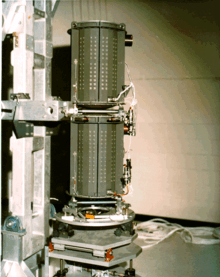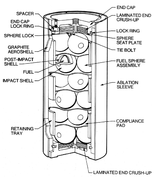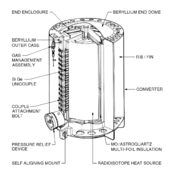MHW-RTG
The Multihundred-Watt radioisotope thermoelectric generators (MHW RTG) is a type of US radioisotope thermoelectric generator (RTG) developed for the Voyager spacecraft.[1]

Each RTG had a total weight of 37.7 kg including about 4.5 kg of Pu-238.[2] It uses 24 pressed plutonium-238 oxide spheres and provides enough heat to generate approximately 157 watts of electrical power initially - halving every 87.7 years.
Each RTG generated about 2400 Watts of thermal power.[3] Conversion of the decay heat of the plutonium to electrical power used 312 silicon-germanium (SiGe) thermoelectric couples. The initial thermoelectric couple hot junction temperature was 1273 K (1832 °F) with a cold junction temperature of 573 K (572 °F).[4]
Each Voyager spacecraft has 3 RTGs. Collectively, the RTGs supplied each Voyager spacecraft with 470 watts at launch.[5][6]
-

RTG heat source unit
-

RTG diagram 1
-

RTG unit
MHW-RTGs were used on the Lincoln Experimental Satellites 8 & 9, and to this day continue to provide power on Voyager 1 and Voyager 2.
Subsequent US spacecraft used the GPHS-RTG which used similar SiGe thermoelectic devices but a different packaging of the fuel.
References
- ↑ Heacock (1980). "The Voyager Space Craft". Proceedings of the Institution of Mechanical Engineers Vol 194 1980 pps 267 - 270.
- ↑ "Space Nuclear Power" G.L.Bennett 2006
- ↑ http://www.totse.com/en/technology/space_astronomy_nasa/spacnuke.html
- ↑ Furlong, Richard R.; Wahlquist, Earl J. (1999). "U.S. space missions using radioisotope power systems" (PDF). Nuclear News. 42 (4): 26–34. Retrieved January 2, 2011.
- ↑ "VOYAGER 2:Host Information". NASA. 1989. Retrieved January 2, 2011.
- ↑ "Voyager 2 Craft Details". NASA-NSSDC-Spacecraft-Details. NASA. Retrieved March 9, 2011.